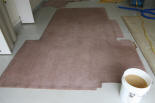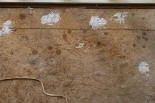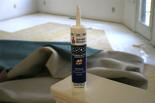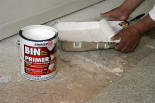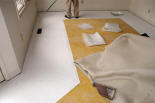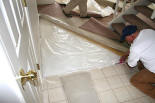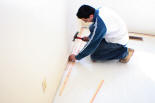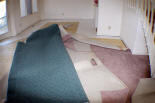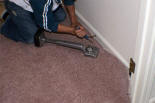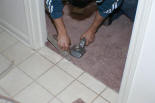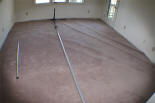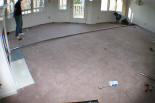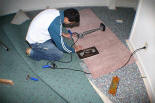| Salvaging Pee-Soaked Subfloor (Right click here to download a PDF file 446KB in size covering the "cat pee condo" case study AND this page about salvaging pee-soaked subfloor.) Most customers can solve their pet odor problems by simply pouring or spraying DooDoo Voodoo on their stinky areas, then letting the product air dry naturally. This can even be the case where repeated urination has occurred, despite what you might think. DooDoo Voodoo is that effective. There are times, though, when more invasive measures might be necessary. This document addresses how to go about salvaging your subfloor if repeated urination has trashed it. Note that while we were dealing with wooden subfloor, these guidelines also generally apply to concrete subfloors (slabs), too. For example, at the condominium we recently undertook as a project, DooDoo Voodoo alone solved virtually all the odor problems throughout the dwelling, even in spots where the blacklight showed us that cats had repeatedly sprayed. There were three spots in the condo, though, where years of repeated urination had trashed the subfloor to such an extent that additional work was required. Now, before going to the extent we did here, I suggest you first learn more about our subsurface extraction tools, available on our PRODUCTS page (and on the linked-to SUBSURFACE page). These tools, which you use with a carpet extractor (yours or a rental) or a wetvac, do a fantastic job of drawing offensive soiling out of your carpet fibers, backing, pad and subfloor. In fact, DooDoo Voodoo and a subsurface extraction can salvage virtually all "trashed" carpet, pad and subfloor. The best news? Doing subsurface extraction is WAY easier than regular carpet cleaning...and the tools start at just $39.99! You Think Your Place Is Bad? As you can see, the urine had literally begun to rot the OSB (Oriented Strand Board) subfloor in this area, as well as in two other localized spots in the condo. DooDoo Voodoo was repeatedly applied to the subfloor and may have ultimately been successful, but time was of the essence (the owner wanted to get the condo on the market), so we opted to go a step further right away instead of waiting for DooDoo Voodoo to get us the other 5% toward our goal of total odor remediation. While the crew was onsite, it was decided to go ahead and replace the carpet pad & tack strips, and seal the subfloor, in other areas than just the three where rot had occurred. Bear in mind that DooDoo Voodoo alone had solved the odor issues in these additional areas; the extra work we did was just a safety net (as home & condo buyers sometimes try to come back at the seller and make issues over odors that crop up down the road). I have total confidence that due to DooDoo Voodoo's effectiveness, no odors would have cropped up in the future; the additional work was just icing on the cake. Now that we've set the stage, here's what we did to rid this area, a landing at the top of the stairs, of odor. First, we pulled up the carpet and moved it to the garage. We then removed the pee-soaked carpet tack strips and the old carpet pad. Here's a close-up of the old, pee-soaked tack strip: Next, we pulled all the staples and nails that remained, then sealed the holes with Sherwin-Williams 950A caulk, which is what we recommend and have used extensively in our own animal rescue facility. The first picture was taken before our helpers caulked the seam between pieces of subflooring, which is also recommended: Next, we sealed the subfloor with BIN, a KILZ-like product made by Zinsser, which we've historically found superior to KILZ, especially with regard to blocking odors. Zinsser makes a few different versions of BIN and other products, not all of which are appropriate for sealing in odors. They say their "ultimate" odor sealer is Clear BIN Sealer, which is not the product we used on the cat pee condo project. Being shellac-based, it's likely got some strong odor while it's wet, but they say it dries to the touch in 15 minutes and the odor then dissipates. To learn more about Clear BIN Sealer, visit this link. Someone we know recently used a different Zinsser product, Odorless Oil-Base Stain Blocker, on cat pee odor and said it worked fabulously and did, indeed, have no odor of its own. (This product isn't touted as being intended for sealing in odors, but our friend said it worked like a charm on pee-soaked subflooring. Being odorless, it seems more appropriate for use around animals.) We recently purchased some KILZ Oil-Based Low Odor sealer and look forward to trying it. The KILZ product IS touted as being good for sealing in odors. Note that the following two pictures were taken in other rooms of the condo, not at the top of the stairs. (I mention this to illustrate that while we were at it, the decision was made to charge forward a bit more than planned, so in some areas we cut away a 33" strip of the old pad, removed the tack strips, caulked the holes, sealed the subfloor and replaced the tack strips. This method was chosen in lieu of removing all the rooms' pad because DooDoo Voodoo alone had controlled the odors and had allowed the carpet, which was estimated it would cost up to $12,000 to replace, to be salvaged. Why did we cut away a 33" strip of pad? Because pad sells in 6'-wide rolls, so 33" was a safe distance to get the maximum coverage from the new pad without waste and without needing more than 1/2 the width of a roll.) Once three coats of BIN had been applied (it dries in 45 minutes), we covered the sealed areas with thick plastic sheeting (we recommend 4-mil. or thicker), cut to fit and affixed with staples. If you do this, use as few staples as possible; just enough to hold the plastic in place. The less penetrations through the sealed subfloor, the better, odor-wise. Once the plastic sheeting was in place, our carpet layers installed new tack strips and 6# rebond carpet pad: After the guys had all the pad and new tack strips installed, they essentially re-installed the carpet throughout the condo. This may sound more daunting or expensive than it actually is. Actually, it only cost 5% as much as what new carpet might have cost, which obviously makes it a viable method for most homeowners. Note: having been in place for nearly 10 years, the carpet had gotten quite stretched, though the stretching wasn't visible to the naked eye. This stretching makes carpet wear out faster, so an added benefit of having the carpet re-installed was that the guys were able to tighten it up quite a bit, thus making for a better-looking, longer-lasting installation. Here are a few pictures taken before and during the re-installation of the carpet. In the last picture, Ricardo is securing a seam where the room's carpet (which had been soiled with the condo owner's late mother's urine, as well as animal urine) meets the new piece of carpet we installed in the closet. The long gizmo shown in two of the pictures is used to power stretch carpet back into place across the vast expanse of a room or rooms. Once all the carpet was back down, we treated a few spots for staining and odor, then gave the condo's carpet a thorough conventional cleaning. You'd never know from looking at the carpet that it's (a) as old as it is; (b) been peed on as many times as it has; or (c) was in such a state of disarray while our work was underway. Even after paying for DooDoo Voodoo, sealer, plastic sheeting, carpet re-installation, pad and some general labor, the condo's owner saved a LOT of money versus what she would have had to spend to replace all the carpet & pad (which still would've required all the subfloor work we did anyway)...not to mention saving a lot of money versus having to drop the condo's price $50,000 because of the odor and related condition. All told, to drop the price, replace the carpet and perform all the odor remediation & subfloor work might have cost this lady $72,000 or more, but she spent a small fraction of that amount and sold the place quickly. The owner reported to us that not one of the people to whom she showed the condo remarked about odor and the people who ended up buying it remarked about the condo's "fresh, clean smell." The biggest news is that the people who bought the condo said they were not going to replace the carpet 'cause it "looked like new" and matched their furniture. As we like to say around here, "That's the answer we were looking for." DooDoo Voodoo and a little extra attention to the carpet & subfloor paid off in a major way for this homeowner...and can pay off for you, too. If you have questions for us about the work we did, or live in the Indianapolis area and are in need of such services at your house, feel free to e-mail us. (Right click here to download a PDF file 446KB in size covering the "cat pee condo" case study AND this page about salvaging pee-soaked subfloor.) ### Note: We recommend wearing a mask or respirator while performing work such as is described here. We have found the R95 mask by 3M, available at most home improvement centers for $6 or so, to work well. Some people may benefit instead from a dual-canister respirator mask, which may be more effective. We also recommend wearing disposable exam gloves when working extensively with DooDoo Voodoo. You as the user determine suitability of DooDoo Voodoo and recommended measures for your particular purpose and assume all liability. Exercise common sense and caution when doing such remediation work.
|
